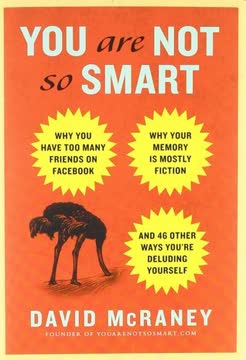Key Takeaways
1. Bad is stronger than good: The negativity effect shapes our perceptions
"Bad is stronger than good."
The negativity effect is a fundamental psychological principle that negative events, emotions, and information have a greater impact on us than positive ones. This bias manifests in various aspects of life:
- Relationships: One criticism can outweigh multiple compliments
- Work: Negative feedback is remembered more than praise
- Decision-making: Potential losses loom larger than potential gains
The power of bad evolved as a survival mechanism, helping our ancestors avoid threats. However, in modern life, this bias can lead to:
- Overreacting to minor setbacks
- Dwelling on negative experiences
- Making poor decisions based on fear rather than opportunity
Understanding the negativity effect allows us to consciously counteract it, leading to more balanced perceptions and decisions.
2. Relationships thrive on positivity ratios and avoiding negative interactions
"It takes four good things to overcome one bad thing."
The Rule of Four is a guideline for maintaining healthy relationships. Research shows that successful couples have at least five positive interactions for every negative one. This principle applies to various relationships:
- Romantic partnerships
- Friendships
- Work relationships
To apply the Rule of Four:
- Actively create positive moments (compliments, gestures of affection)
- Minimize negative interactions (criticism, contempt)
- When conflicts arise, follow up with multiple positive interactions
Remember that avoiding negative interactions is more crucial than increasing positive ones. Strategies for minimizing negativity include:
- Practicing active listening
- Expressing appreciation regularly
- Addressing issues calmly and constructively
By maintaining a positive ratio and avoiding harmful behaviors, relationships become more resilient and satisfying.
3. The brain's negativity bias evolved for survival but can be overcome
"The brain uses so much energy to focus on the new threat that the previous pleasantness gets lost because of an effect called retroactive interference."
Our brains are wired to prioritize negative information as a survival mechanism. This manifests in several ways:
- Stronger neural responses to negative stimuli
- Greater attention and memory for negative events
- Tendency to interpret ambiguous situations negatively
However, we can consciously override this bias:
- Awareness: Recognize when the negativity bias is influencing thoughts
- Reframing: Actively look for positive aspects in situations
- Mindfulness: Practice being present to avoid dwelling on negatives
- Gratitude: Regularly acknowledge positive aspects of life
Techniques like cognitive behavioral therapy (CBT) can help retrain the brain to respond more balanced to both positive and negative information. By understanding and countering our innate negativity bias, we can make more rational decisions and lead happier lives.
4. Criticism and penalties are powerful motivators when used strategically
"Bad is universally powerful, but it is not invincible."
Strategic use of negativity can be a powerful tool for motivation and improvement. While positive reinforcement is important, research shows that penalties and criticism, when used correctly, can be more effective:
- Penalties motivate more than rewards in many situations
- Constructive criticism leads to faster learning and improvement
Key principles for effective use of negativity:
- Be specific and actionable in criticism
- Balance negative feedback with positive reinforcement
- Focus on behaviors, not personal attributes
- Use penalties as a last resort, not a first response
Examples of effective negative motivation:
- Performance-based pay cuts in addition to bonuses
- Clear consequences for missed deadlines or targets
- Constructive feedback sessions focused on improvement
When used judiciously, negative motivation can drive significant personal and organizational growth. However, it's crucial to maintain a overall positive environment to prevent demotivation and burnout.
5. Bad apples spoil organizations, but their impact can be mitigated
"The strongest predictor of team functioning turned out to be the score of the worst person in the group."
Toxic individuals can have a disproportionate negative impact on team and organizational performance. Research identifies three types of "bad apples":
- The jerk: Rude, insulting, and disrespectful
- The slacker: Chronically underperforming and unreliable
- The downer: Constantly pessimistic and complaining
These individuals can:
- Lower team morale and productivity
- Increase turnover rates
- Damage organizational culture
Strategies to mitigate the impact of bad apples:
- Implement rigorous hiring processes to screen for toxic traits
- Address problematic behaviors quickly and directly
- Provide support and training for improvement
- If necessary, remove toxic individuals from the team
Creating a culture of accountability and positive behavior helps prevent the spread of negativity. By addressing "bad apples" promptly, organizations can maintain a healthy and productive environment.
6. Online reviews amplify negativity, requiring proactive management
"A single bad experience still has a disproportionate impact—an unhappy Amazon book buyer is more likely than a happy customer to post a review."
The online review landscape amplifies the negativity effect, as dissatisfied customers are more motivated to share their experiences. This can significantly impact businesses:
- One negative review can outweigh multiple positive ones
- Potential customers focus more on negative reviews
- Overall ratings can be skewed by a few vocal critics
Strategies for managing online reputation:
- Actively encourage satisfied customers to leave reviews
- Respond promptly and professionally to negative feedback
- Address issues raised in reviews to show responsiveness
- Monitor review trends to identify and fix recurring problems
Case study: The Casablanca Hotel in New York maintains a top TripAdvisor rating by:
- Creating multiple positive touchpoints with guests
- Proactively addressing potential issues
- Responding thoughtfully to all reviews, especially negative ones
By understanding and managing the negativity bias in online reviews, businesses can maintain a positive online reputation and attract customers.
7. The Pollyanna principle: Humans have an innate positivity in language and memory
"Language is our great social technology, and we use it to help us get through hard times."
Despite our negativity bias, humans demonstrate an innate tendency towards positivity in language and memory, known as the Pollyanna principle. This manifests in several ways:
- Positive words are used more frequently in most languages
- People tend to recall positive experiences more easily
- Social media posts are generally more positive than negative
This principle serves important social and psychological functions:
- Facilitates social bonding and cooperation
- Helps maintain emotional well-being
- Provides resilience in face of adversity
Examples of the Pollyanna principle in action:
- The prevalence of optimistic phrases in everyday speech
- The tendency to remember vacations fondly, despite minor inconveniences
- The popularity of uplifting content on social media platforms
Understanding this principle can help balance our negativity bias and foster more positive interactions and outlooks.
8. Post-traumatic growth: Adversity can lead to personal development
"Instead of being permanently scarred, they undergo post-traumatic growth (PTG), a term introduced by the psychologists Richard Tedeschi and Lawrence Calhoun."
Adversity can catalyze significant personal growth and development. Post-traumatic growth (PTG) refers to positive psychological changes experienced as a result of struggling with highly challenging life circumstances. Key aspects of PTG include:
- Increased appreciation for life
- Stronger personal relationships
- New perspectives on life
- Greater sense of personal strength
- Spiritual development
Factors that contribute to PTG:
- Social support during and after the traumatic event
- Ability to find meaning in the experience
- Openness to change and new possibilities
Strategies to foster PTG:
- Engage in reflective practices like journaling
- Seek professional help when needed
- Connect with others who have overcome similar challenges
While trauma is inherently negative, recognizing the potential for growth can help individuals navigate difficult experiences and emerge stronger.
9. The crisis industry exploits our negativity bias, distorting reality
"The Crisis Crisis: the never-ending series of hyped threats leading to actions that leave everyone worse off."
The crisis industry capitalizes on our negativity bias to create a constant state of fear and urgency. This includes:
- Media outlets sensationalizing negative events
- Politicians exaggerating threats for political gain
- Special interest groups amplifying potential dangers
Consequences of the crisis mentality:
- Distorted perception of reality
- Misallocation of resources to address exaggerated threats
- Increased anxiety and stress in society
- Neglect of real, but less sensational problems
Strategies to combat the crisis industry:
- Seek out balanced, fact-based information
- Practice critical thinking when consuming news
- Put risks in proper perspective using statistics
- Focus on long-term trends rather than isolated events
By recognizing and resisting the manipulation of our negativity bias, we can develop a more accurate and balanced view of the world.
10. Overcoming negativity bias improves personal wellbeing and societal progress
"Bad will always be stronger than good, but good's prospects are improving."
Consciously counteracting our negativity bias can lead to significant improvements in personal wellbeing and societal progress. Benefits include:
- Improved mental health and life satisfaction
- Better decision-making in personal and professional contexts
- More resilient relationships and communities
- Increased innovation and problem-solving capacity
Strategies for overcoming negativity bias:
- Practice gratitude regularly
- Seek out and celebrate positive news and achievements
- Reframe negative experiences as opportunities for growth
- Cultivate a growth mindset that embraces challenges
On a societal level, overcoming negativity bias can lead to:
- More rational policy-making based on evidence rather than fear
- Increased investment in long-term solutions to global challenges
- Greater cooperation and trust between individuals and groups
By understanding and mitigating our negativity bias, we can create a more balanced, optimistic, and progress-oriented world.
Last updated:
FAQ
What's The Power of Bad about?
- Explores negativity bias: The book delves into the "negativity effect," where negative events and emotions impact us more than positive ones, affecting our decisions and perceptions.
- Counteracting negativity: Authors John Tierney and Roy F. Baumeister offer strategies to manage this bias, emphasizing personal growth through understanding negative experiences.
- Applications across fields: It applies the negativity effect to relationships, business, and politics, showing its influence on behavior and decision-making.
Why should I read The Power of Bad?
- Understanding psychology: Gain insights into the psychological mechanisms behind our reactions to good and bad experiences, improving emotional resilience.
- Practical strategies: The book offers actionable advice to mitigate negativity in personal and professional contexts, enhancing well-being and productivity.
- Relevance today: In a world dominated by social media, the book's insights on negativity's spread are timely, helping readers navigate a landscape where bad news often overshadows good.
What are the key takeaways of The Power of Bad?
- Negativity bias is universal: Negative experiences have a more profound impact than positive ones, potentially distorting judgment and decision-making.
- The Rule of Four: It takes four positive experiences to outweigh one negative, guiding individuals to assess relationships and environments realistically.
- Constructive criticism's role: While painful, criticism is a tool for growth, and learning to handle it effectively can improve personal and professional outcomes.
How does the negativity effect influence relationships in The Power of Bad?
- Criticism's impact: Negative interactions like criticism can significantly affect relationships, leading to misunderstandings and resentment if unmanaged.
- Positive interaction importance: Successful relationships require a higher ratio of positive to negative interactions, as suggested by the "Gottman ratio."
- Improvement strategies: Focus on constructive communication and minimize harmful interactions to strengthen bonds and improve satisfaction.
What is the Rule of Four in The Power of Bad?
- Four positives to one negative: This rule suggests it takes four positive experiences to counterbalance one negative, serving as a guideline for relationship health.
- Contextual application: Use this rule to evaluate personal relationships, workplace dynamics, and parenting strategies, fostering supportive interactions.
- Encouragement for positivity: Focus on creating positive experiences rather than avoiding negatives, leading to greater happiness and fulfillment.
How can I use the power of bad to my advantage according to The Power of Bad?
- Learning from criticism: Reframe criticism as a growth opportunity, enhancing skills and resilience.
- Constructive feedback techniques: Use methods like "dispreferred markers" to deliver criticism effectively, maintaining positive relationships.
- Embracing challenges: Recognize the benefits of bad experiences, embracing challenges for personal growth and success.
What are some effective strategies for delivering criticism in The Power of Bad?
- Ask questions first: Foster a collaborative environment by asking for the recipient's perspective before delivering criticism.
- Balance feedback: Mitigate negative feedback's sting with a higher ratio of positive comments.
- Mindful timing: Deliver criticism timely, allowing the recipient to process and encouraging dialogue for clarity.
How does the negativity effect manifest in the workplace according to The Power of Bad?
- Negativity contagion: Negativity can spread quickly in workplaces, affecting morale and productivity.
- Performance impact: Teams with a "bad apple" perform worse, with negativity leading to decreased motivation and increased conflict.
- Management strategies: Identify and address negative behaviors early, implementing a "no-asshole rule" to maintain a positive culture.
What is the significance of the "no-asshole rule" in The Power of Bad?
- Preventing toxicity: This rule emphasizes avoiding toxic individuals to protect team morale and productivity.
- Team dynamics focus: A team's performance often hinges on its weakest member, so prioritize overall group health.
- Long-term benefits: A harmonious workplace leads to higher satisfaction and retention, fostering a culture of respect and support.
What is the negativity effect as defined in The Power of Bad?
- Definition: The negativity effect is where negative experiences impact thoughts and behaviors more than positive ones, skewing perceptions.
- Real-life implications: It affects relationships, workplace dynamics, and public opinion, necessitating effective emotional response navigation.
- Counteracting strategies: Focus on positive experiences and practice gratitude to build resilience against negativity.
How does the peak-end rule work in The Power of Bad?
- Understanding the rule: People evaluate experiences based on their most intense moments and endings, influencing memory and judgment.
- Real-life application: Businesses can enhance satisfaction by creating positive peaks and endings, leading to better reviews and loyalty.
- Psychological studies: Studies show experiences judged more favorably if ending positively, despite discomfort duration.
What are the best quotes from The Power of Bad and what do they mean?
- "Bad is stronger than good.": Highlights negativity's pervasive influence, reminding us to be mindful of its overshadowing effect.
- "You can’t repeal the Rule of Four.": Stresses maintaining a higher positive-to-negative experience ratio in relationships.
- "Criticism is like pain in the human body.": Reflects criticism's discomfort but essential role in growth, encouraging constructive feedback embrace.
Review Summary
The Power of Bad receives mixed reviews, with praise for its insights on negativity bias and practical strategies to overcome it. Readers appreciate the book's research and applicability to relationships and personal growth. However, some criticize its bias, oversimplification of complex issues, and reliance on questionable studies. The book's exploration of how negativity affects various aspects of life, from relationships to societal issues, is generally well-received. Critics note potential oversights in addressing systemic problems and climate change, while supporters find the book's perspective refreshing and potentially life-changing.
Similar Books










Download PDF
Download EPUB
.epub digital book format is ideal for reading ebooks on phones, tablets, and e-readers.




